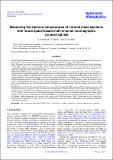Files in this item
Measuring the electron temperatures of coronal mass ejections with future space-based multi-channel coronagraphs : a numerical test
Item metadata
| dc.contributor.author | Bemporad, Alessandro | |
| dc.contributor.author | Pagano, Paolo | |
| dc.contributor.author | Giordano, Silvio | |
| dc.date.accessioned | 2019-03-06T13:30:05Z | |
| dc.date.available | 2019-03-06T13:30:05Z | |
| dc.date.issued | 2018-11 | |
| dc.identifier | 258059124 | |
| dc.identifier | 285e866e-02ed-43d4-9f2b-ca1bd75496df | |
| dc.identifier | 85056279433 | |
| dc.identifier | 000448965000001 | |
| dc.identifier.citation | Bemporad , A , Pagano , P & Giordano , S 2018 , ' Measuring the electron temperatures of coronal mass ejections with future space-based multi-channel coronagraphs : a numerical test ' , Astronomy & Astrophysics , vol. 619 , A25 . https://doi.org/10.1051/0004-6361/201833058 | en |
| dc.identifier.issn | 0004-6361 | |
| dc.identifier.uri | https://hdl.handle.net/10023/17229 | |
| dc.description | Funding: This research has received funding from the European Research Council (ERC) under the European Union’s Horizon 2020 research and innovation program (grant agreement No. 647214). | en |
| dc.description.abstract | Context. The determination from coronagraphic observations of physical parameters of the plasma embedded in coronal mass ejections (CMEs) is of crucial importance for our understanding of the origin and evolution of these phenomena. Aims. The aim of this work is to perform the first ever numerical simulations of a CME as it will be observed by future two-channel (visible light VL and UV Ly-α) coronagraphs, such as the Metis instrument on-board ESA-Solar Orbiter mission, or any other future coronagraphs with the same spectral band-passes. These simulations are then used to test and optimize the plasma diagnostic techniques to be applied to future observations of CMEs. Methods. The CME diagnostic techniques are tested here by analyzing synthetic coronagraphic observations. First, a numerical three-dimensional (3D) magnetohydrodynamic (MHD) simulation of a CME is performed, and the plasma parameters in the simulation are used to generate synthetic visible light (VL) and ultraviolet (UV) coronagraphic two-dimensional (2D) images of the eruption (i.e., integrated along the line-of-sight). Second, synthetic data are analyzed with different assumptions (as will be done with real data), to infer the kinematic properties of the CME (such as the extension along the line-of-sight of the emitting region, the expansion speed, and the CME propagation direction), as well as physical parameters of the CME plasma (the plasma electron density and temperature). A comparison between input parameters from the simulation and output parameters from the synthetic data analysis is then performed. Results. The inversion of VL polarized data allows to successfully determine the CME speed and 3D propagation direction (with the polarization ratio technique), as well as to derive information on the extension along the line-of-sight of the emitting plasma, a crucial parameter needed to convert the plasma electron column densities into number densities. These parameters are used to analyze UV Ly-α images and to estimate the CME plasma temperature, also taking into account Doppler dimming effect. Output plasma temperatures are in general underestimated, both in the CME body and core regions. By neglecting the UV Ly-α radiative excitation of H atoms, reliable temperatures can be more easily derived in the CME core (within ∼60%). On the other hand, we show that a determination of temperatures (within ∼20−30%) in the CME body requires 2D maps of CME radial speeds and Doppler dimming coefficients to be derived. | |
| dc.format.extent | 12 | |
| dc.format.extent | 1450789 | |
| dc.language.iso | eng | |
| dc.relation.ispartof | Astronomy & Astrophysics | en |
| dc.subject | Sun: coronal mass ejections (CMEs) | en |
| dc.subject | Sun: UV radiation | en |
| dc.subject | Methods: numerical | en |
| dc.subject | Methods: data analysis | en |
| dc.subject | Plasmas | en |
| dc.subject | QB Astronomy | en |
| dc.subject | QC Physics | en |
| dc.subject | T-NDAS | en |
| dc.subject.lcc | QB | en |
| dc.subject.lcc | QC | en |
| dc.title | Measuring the electron temperatures of coronal mass ejections with future space-based multi-channel coronagraphs : a numerical test | en |
| dc.type | Journal article | en |
| dc.contributor.sponsor | European Research Council | en |
| dc.contributor.institution | University of St Andrews. Applied Mathematics | en |
| dc.identifier.doi | 10.1051/0004-6361/201833058 | |
| dc.description.status | Peer reviewed | en |
| dc.identifier.grantnumber | 647214 | en |
This item appears in the following Collection(s)
Items in the St Andrews Research Repository are protected by copyright, with all rights reserved, unless otherwise indicated.

